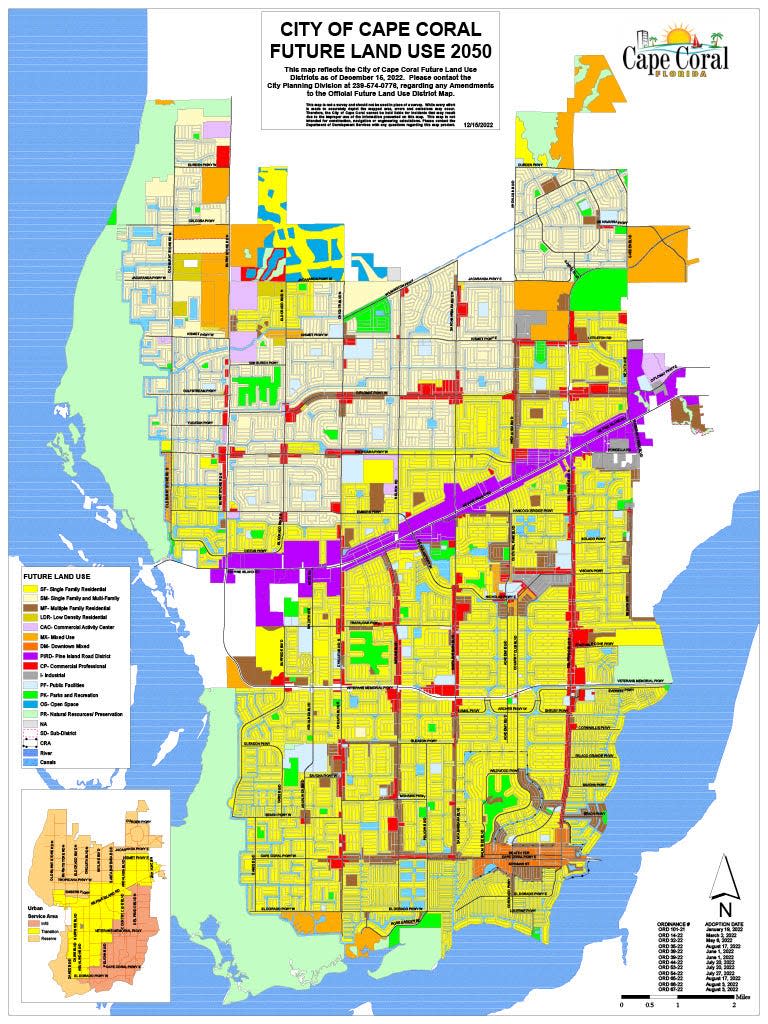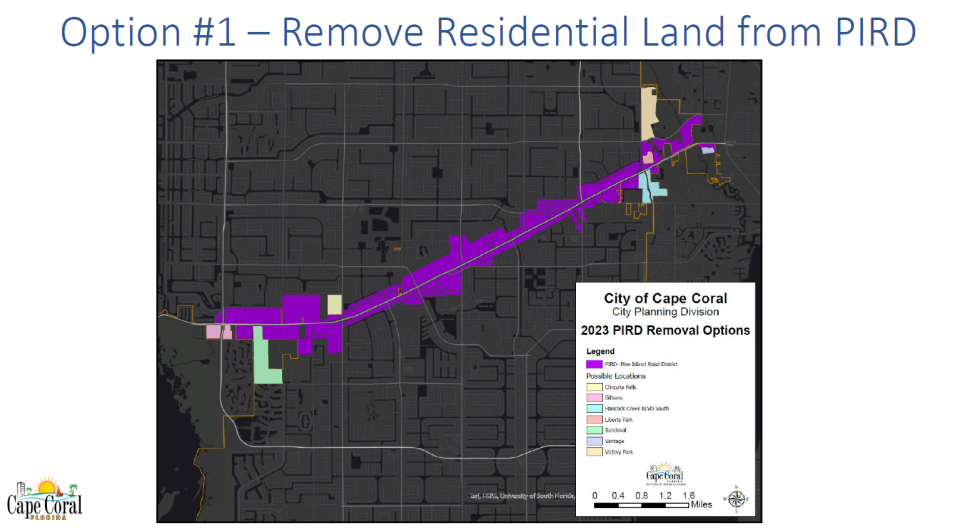Cape Coral considers raising caps as Pine Island Road District reaches residential limits

Cape Coral's rapidly growing Pine Island Road District is reaching its limits for residential units, marking a possible end to future multifamily housing developments there.
According to city documents, there are projects with 4,800 housing units under review, and pre-application projects with 2,300 units, which will soon breach the residential cap limits in the corridor. There are already about 2,300 residences in the area.
The residential cap in the district is 5,030 units.
The Pine Island Road District was established in 2002 as a mixed-use district that contains developments with retail, professional office, industrial, hotels, and residential uses. It's approximately 2,590 acres.
According to the Cape Coral Economic Development Master Plan, the majority of jobs in Cape Coral are within the Del Prado corridor and the Pine Island Road corridor.
What's the issue?
Wyatt Daltry, the planning team coordinator with the city of Cape Coral, presented the issue to the city council last week.
When the district was established, it required development caps by the then-state land planning agency.
Daltry said the reason these caps were placed was because the district was smaller before several annexations added more land to the district; Pine Island Road between Burnt Store Road and Chiquita Boulevard was only two lanes instead of the now four lanes, and there were not centralized utilities available throughout the district in 2002.
He said the city has several areas in the district that are single-use residential areas that count against the development cap and removing them could give the room for city more residential units within the district.
These examples include the northern half of Sandoval, the Crossings, Casa di Fiore, and the Royal Hawaiian Club.
Development permits will not be issued once the cap is reached.
Some potential consequence of the cap being breached is that the city will not be consistent with its comprehensive plan and could suffer legal exposure if they are forced to stop residential developments already in the pipeline from moving forward.
"Because the comprehensive plan has legal standing, we will be unable to issue development permits for units once that residential cap has been reached," Daltry said.
City Manager Michael Ilczyszyn said the city started informing developers of this issue a month ago, and the city is looking into several options to solve this problem.
"We are not looking for one single solution to solve the problem here," Ilczyszyn said. "What we are looking to do is put forward a basket of solutions that we would utilize together to move forward."
Recent Cape Coral news Long time Cape Coral employee Michael Ilczyszyn becomes city manager at $285,000/year
Other Cape Coral news Design for the $300 million Cape Coral Bridge project chosen; construction to begin in 2026
Options available
The Cape Coral City Council was presented with several options from the city staff:
Remove residential units from the Pine Island Road District;
Increase the residential cap;
Remove development caps for retail, hotels, and other commercial units in the district, but keep the residential caps
Maintain status quo
Option one would require future land use map amendment changes and rezones.
There are thousands of residential units within the district that can be removed: Sandoval, Gilbane, Chiquita Falls, Victory Park, Liberty Park, Hancock Creek South Boulevard, and Vantage Apartments.
Florida Senate Bill 250 restricts city-initiated amendments from adopting harsher land-use regulations, so this route would require privately-initiated requests by property owners. The city would cover these property owner's application and notice fees, which are estimated at $49,150.
However, the district would still be over the cap by 405 residential units.
Option two is increasing the development caps by 35%, which would raise the maximum to 6,791 residential units.
This option would require a text amendment to the comprehensive land-use plan and would not be affected by Senate Bill 250 as the city would be relaxing restrictions for future development.
It would take about five months.
Option three would do away with the caps for retail, office, and hotel rooms in the district, but keep residential caps.
This option is proposed as a package deal with option two and has a residential cap of 6,791 residential units.
"We are not recommending removing the residential caps because one of our concerns is that the Pine Island Road District could be primarily a residential corridor, which given the roughly pre-platted community, given the fact that we don't have large properties in Cape Coral, we don't want to do that with this roadway," Daltry said.
"Worst case scenario would be build-out of over 50,000 units," he added.
Senate Bill 250 would not be an issue here either.
Vertically-integrated mixed-use, residential above a retail/office space, would be permitted and not counted against the residential cap.
The last option would maintain things as they are, but staff advised against this as legal exposure exists for the city.
Staff recommended combining options 1, 2, and 3 to solve this residential cap issue.

How do apartments and condominiums factor?
Mayor John Gunter started the discussion by asking about the city's need for multifamily housing and how that factors into the Pine Island Road District.
Amy Yearsley, Cape Coral housing coordinator, said a study done on housing needs found that the city needed an additional 704 apartment units per year to keep up with growth and demand.
Yearsley said the bulk of apartment units that came online in 2022-2023 were outside of the district.
"We really have moved forward as far as the units we need," Yearsley said.
Ilczyszyn said if the city moves forward with all three options, the city is buying a year and there will be no more multifamily on Pine Island Road District.
"Even with the solutions, I don't want you to think that there's an open-ended door here forever unless a developer does, through option three, a vertically integrated multifamily housing," Ilczyszyn said. "By doing all the others, we basically buy ourselves a year to accomplish all that and balance everything out, and then we are in the same exact position, which is there is no more multifamily."
Council discussion
Councilmember Keith Long questioned the three options to increase the residential caps as he said the council since he's been there has been "commercial forward" and gone to some length to prevent an increase in multifamily.
"Why the options that were presented, almost none of them are in line with the fact that, accidentally, this sort of achieves that goal," Long said.
He asked staff for clarification on why maintaining the corridor as is would be problematic.
City Attorney Aleksandr Boksner said the city is being mindful of the due diligence obligations of some of the projects already in process and the potential implication of not addressing this issue.
Ilczyszyn said developers are working their way through reviews with the understanding that there is still some cap capacity available.
Councilmember Robert Welsh said he would be open to doing options 1-3 but at a lower capacity. He would remove the properties in Victory Park, Chiquita Falls, Sandoval, and Hancock Creek South, and increase the caps by 15%.
Another council member, Bill Steinke, agreed with removing the properties Welsh listed as they are not facing Pine Island Road, and he supported vertically integrated mixed-use in the corridor.
Councilmember Patty Cummings said she felt "uncomfortable" deciding as they were supposed to have a full committee of the whole meeting on this topic.
"I just want to make sure that we are pretty much on the same page," Cummings said.
Gunter agreed with Long's assessment of the situation.
He saw this more as a discussion on what's important for the Pine Island Road District, commercial or multifamily, and said the council should focus on commercial development for the city.
"It's almost like we are trying to fix a problem that we don't have a need for," Gunter said. "If we need more multifamily, then you put policies in place for more multifamily."
He does support increasing the development caps by 15% and vertically integrated mixed-use.
Councilmember Dan Sheppard agreed with what the mayor said and wanted to see an increase in development caps.
Councilmember Jessica Cosden agreed with going through with options two and three.
Finally, Councilmember Tom Hayden wasn't ready to decide on a percentage increase on the cap.
The council will come back to discuss this topic at a committee of the whole meeting on Oct. 11.
Luis Zambrano is a Watchdog/Cape Coral reporter for The News-Press and the Naples Daily News. You can reach Luis at Lzambrano@gannett.com. Follow him on Twitter @Lz2official.
This article originally appeared on Fort Myers News-Press: Cape Coral bringing development changes to Pine Island Road District

